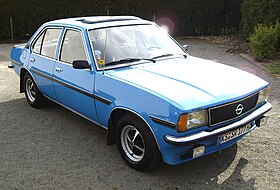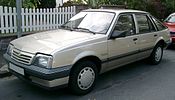
The Vauxhall Chevette is a supermini car that was manufactured by Vauxhall in the United Kingdom from 1975 to 1984. It was Vauxhall's version of the "T-Car" small-car family from Vauxhall's parent General Motors (GM), and based primarily on the Opel Kadett C. The family also included the Isuzu Gemini in Japan, the Holden Gemini in Australia, the Chevrolet Chevette in the United States, Canada, Brazil, Colombia, Ecuador and Argentina, and in the U.S. and Canada it was also rebadged as the Pontiac Acadian/Pontiac T1000.

The Vauxhall Astra is a compact car/small family car (C-segment) that has been sold by Vauxhall since 1980. Over its eight generations, it has been made at several GM/Opel/Stellantis plants around Europe - however most versions have been sourced from Vauxhall's plant at Ellesmere Port, Cheshire, England.
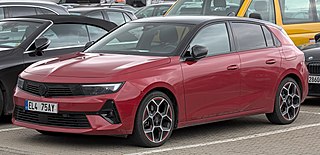
The Opel Astra is a compact car/small family car (C-segment) developed and produced by the German automaker Opel since 1991, currently at its sixth generation. It was first launched in September 1991 as a direct replacement to the Opel Kadett. As of 2022, the car slots between the smaller Corsa supermini and the larger Insignia large family car.

The Opel Vectra is a mid-size car that was engineered and produced by the German automaker Opel from 1988 until 2010. Available in saloon, hatchback and estate body styles, the Vectra was also sold by the Vauxhall marque in the United Kingdom as the Vauxhall Cavalier from 1988 to 1995 and then as the Vauxhall Vectra from 1995 to 2008, and it was also sold by Holden in Australia as the Holden Vectra, by Chevrolet in Latin America as the Chevrolet Vectra.

The Vauxhall Cavalier is a large family car that was sold primarily in the United Kingdom by Vauxhall from 1975 to 1995. It was based on a succession of Opel designs throughout its production life, during which it was built in three incarnations. The first generation of Cavalier, launched in 1975 and produced until 1981, was Vauxhall's version of the General Motors 'U-Car' - essentially an Opel Ascona B/ Opel Manta with a few minor visual differences.
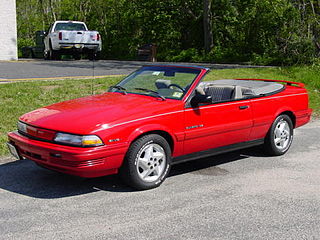
The Pontiac Sunbird is a model line that was manufactured and marketed by Pontiac from the 1976 to the 1994 model years. Loosely deriving its name from the Pontiac Firebird, the Sunbird was introduced as the eventual replacement for the Pontiac Astre, replacing it entirely in 1978 as the smallest Pontiac.

The Opel Kadett is a small family car produced by the German automobile manufacturer Opel from 1936 until 1940 and then from 1962 until 1991, when it was succeeded by the Opel Astra.

The Chevrolet Chevette is a front-engine, rear-drive subcompact manufactured and marketed by Chevrolet for model years 1976–1987 as a three-door or five-door hatchback. Introduced in North America in September 1975, the Chevette superseded the Vega as Chevrolet's entry-level subcompact, and sold 2.8 million units over 12 years. The Chevette was the best-selling small car in the U.S. for model years 1979 and 1980.

The Chevrolet Cavalier is a line of compact cars produced by Chevrolet. Serving as the replacement of the Chevrolet Monza, the Cavalier was the second Chevrolet model line to adopt front-wheel drive. Three versions of the Cavalier have been sold, including three generations sold in North America sold from the 1982 to 2005 model years, a version produced by SAIC-GM for China from 2016 to 2021, and a SAIC-GM version produced for Mexico since the 2019 model year.

The Opel Monza is an executive fastback coupe produced by the German automaker Opel from 1977 to 1986. It was marketed in the United Kingdom as the Vauxhall Royale Coupé by Vauxhall.

The Opel Rekord is a large family car which was built in eight generations by the German car manufacturer Opel. Between 1953 and 1986, approximately ten million were sold.

The Opel OHV family is a pushrod inline-four engine. It was the first all-new engine developed by Opel of Germany after World War II and was released in 1962. Versions were in use through 1993.

The Opel Manta is a rear-wheel-drive sports coupé built by German manufacturer Opel in two generations from 1970 to 1988. The Manta was a mildly sporting coupé based on the Ascona family car, akin to the Ford Falcon-based Mustang and its various imitators such as the Ford Capri. The Manta remained rear-wheel drive for both generations and also saw certain competition success. Its name comes from the manta ray.

The Family II is a straight-4 piston engine that was originally developed by Opel in the 1970s, debuting in 1981. Available in a wide range of cubic capacities ranging from 1598 to 2405 cc, it simultaneously replaced the Opel CIH and Vauxhall Slant-4 engines, and was GM Europe's core mid-sized powerplant design for much of the 1980s, and provided the basis for the later Ecotec series of engines in the 1990s.

The Opel Kadett C is a small family car which was produced by the German automobile manufacturer Opel from 1973 to 1979. The Kadett C, which was the fourth generation of the Opel Kadett, was released in August 1973, and was Opel's version of the General Motors "T-Car". It was the last small Opel to feature rear-wheel drive, and remained in production at Opel's Bochum plant until July 1979, by which time Opel had produced 1,701,076. Of these, 52% had been exported outside West Germany, most of them to markets in other parts of western Europe. In other world markets, however, various badge engineered versions of the Kadett C remained in production as late as the mid-1990s under other GM brand names.

The Opel Corsa is a supermini car engineered and produced by the German automobile manufacturer Opel since 1982. Throughout its existence, it has been sold under a variety of other brands owned by General Motors and also spawned various other derivatives.

The Opel Rekord Series E is an executive car that replaced the Rekord D on Opel's Rüsselsheim production lines in August 1977, following the end of the summer vacation plant shut-down. It shared its wheelbase and inherited most of its engines from its predecessor, but the bodies were completely new.
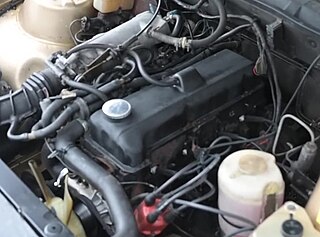
The Opel cam-in-head engine (CIH) is a family of automobile engines built by former General Motors subsidiary Opel from 1965 until 1998, appearing extensively in Opel/Vauxhall badged cars during this period. Both four- and six-cylinder inline configurations were produced. The name derives from the location of the camshaft, which was neither cam-in-block nor a true overhead camshaft. In the CIH engine the camshaft is located in the cylinder head but sits alongside the valves rather than above them, so therefore effectively is still an overhead valve design. The valves are actuated through very short tappets and rocker arms. The engine first appeared in the Opel Rekord B in 1965, and was largely replaced in four-cylinder form by the GM Family II unit as Opel/Vauxhall's core mid-size engine in the 1980s, with the six-cylinder versions continuing until 1994 in the Omega A and Senator B. A large capacity 2.4L four-cylinder version continued until 1998.
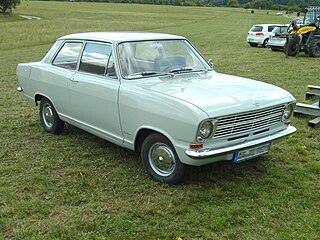
The Opel Kadett B is a car that was launched by Opel at the Frankfurt Motor Show in late summer 1965. The Kadett B was larger all-round than the Kadett A: 5% longer both overall and in terms of the wheelbase, 7% wider and 9% heavier, albeit 10 mm (0.39 in) lower in basic standard "Limousine" (sedan/saloon) form. Production ended in July 1973, with the successor model introduced a month later following the summer shut-down, in August. Unlike its predecessor, it had no relationship with the Vauxhall Viva, which had moved to its own platform for its corresponding second generation.

The Opel Kadett E was introduced in August 1984, and was the sixth generation of the Opel Kadett. and was voted the 1985 European Car of the Year. This model was also developed into a more conventional three-box design with a boot (trunk), badged as the Vauxhall Belmont in the United Kingdom, launched at Frankfurt 1985. There was a station wagon called the "Caravan", available with either three or five doors. In South Africa, the Kadett notchback was sold as the Opel Monza, along with a convertible. This replaced the Opel Ascona.






